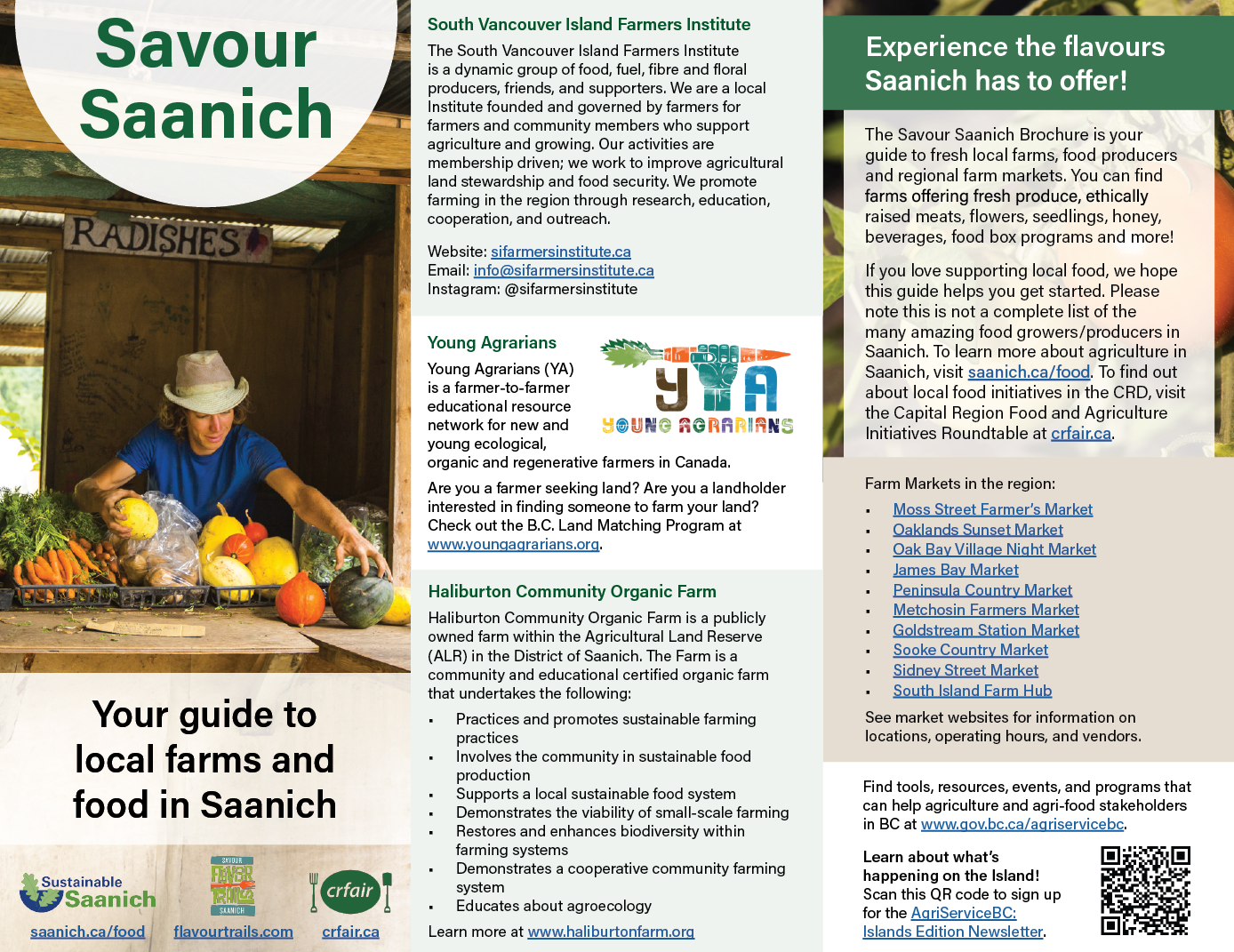Experience the flavours Saanich has to offer!
The Savour Saanich Brochure is your guide to fresh local farms, food producers and regional farm markets. You can find farms offering fresh produce, ethically raised meats, flowers, seedlings, honey, beverages, food box programs and more!
Benefits of Supporting Local Agriculture
The local food system is a fundamental part of a community. Supporting local agriculture benefits farmers, community members, the environment, and the economy in countless ways:
- Environmental Benefits: Local agriculture reduces emissions and food waste by requiring less distance, energy, and packaging to transport and store food. Purchasing local food provides more opportunities for consumers to access information on where their food comes from and what practices and inputs were used to grow and produce it. With more available information, consumers can decide to purchase from local operations that prioritize ecologically mindful farming practices, which can influence a more sustainable local agricultural market. Regenerative agriculture, practiced by many local farmers, improves soil health, benefits the environment in numerous ways and contributes to sustaining viable agricultural land for future generations.
- Economic Benefits: Supporting local agriculture keeps money within the regional economy. The local economy is more likely to succeed as farm businesses and other associated local businesses, such as food markets, grocery stores, restaurants, and processors, are supported directly. As the local economy grows, innovation progresses, leading to even greater economic opportunities. Agricultural operations also provide employment, income, and educational opportunities for local and non-local residents.
- Resilient Communities: A resilient food system reduces the impacts of food insecurity, by providing a sufficient food supply to community members at all times, even through local and global disruptions. Local agriculture leads to reduced reliance on imports and increased access to fresh foods. Increasing access to fresh, high quality food products aids in improving the mental and physical health and resilience of communities.
- Social Benefits: Initiatives generated from local agriculture, such as education opportunities, farm markets, food stands and CSAs create spaces for farmers and community members to build connections with one another. The connections built between community members and farmers aid in building a food system that better suits the individual needs of each community. As farm operations succeed, there are more opportunities for farmers to connect with one another, leading to knowledge sharing, increased support, and a more robust food system.
- Benefits to Local Farmers: Purchasing local food will sustain the vitality of local farm operations. Farmers face numerous obstacles as they work to feed communities with fresh, high-quality foods. Local support is essential in ensuring the continuation of current farm operations and the development of new farm operations. Supporting local farms benefits the community, as well as the livelihood of the farmers. Greater economic benefits for farmers contribute to improved mental and physical health, and opportunities to expand and innovate operations.
Challenges Local Farmers Face
There are numerous challenges that farmers face while growing food, and the list of challenges is only increasing with global disruptions, inflation, a growing population, and a decrease in suitable agricultural land. Some of the biggest obstacles farmers face are:
- Environmental. Climate change is leading to an increase in unpredictable weather, severe storm events, drought, pests, disease, and soil deterioration.
- Biodiversity loss. A decrease in species (animals, plants, insects, microorganisms) and species’ genetics leads to a less diverse ecosystem. An ecosystem lacking diversity is less resilient, less efficient, and more susceptible to diseases, pests, and species extinction.
- Wildlife Conflicts. Wildlife can be extremely destructive to agricultural crops. Investing in infrastructure and deterrents to avoid wildlife conflict can be costly and is sometimes still not effective. Wildlife conflicts only increase the financial burdens and hardships that farmers face. Increased urban environments and decreased biodiversity can cause an unbalanced ecosystem, which may lead to over-population of destructive species.
- Land Availability. Affordability, an increasing population, and pressures to convert arable agricultural land into urban spaces decrease the amount of land available to farmers.
- Financial Barriers. The price of land, equipment, agricultural inputs and associated operational costs has skyrocketed. An increase in the cost of living makes it more difficult for farmers and farm workers to support themselves.
- Urban/Rural Conflicts. Urban sprawl leads to an overlap between urban and rural areas. Agricultural practices leading to noise, smells and dust may be considered a nuisance to urban communities. Altering practices to accommodate this overlap may decrease farm efficiency and increase the stressors farmers face.
- Farm Succession. For various reasons, it is becoming increasingly difficult to find a younger generation interested in farming. The average age of farmers continues to increase and retiring farmers have difficulties finding someone to take over their farm business.
- Service availability. Accessing services required for farm operations, such as storage, processing and distribution facilities, abattoirs, etc. within a reasonable distance can be difficult.
- Labour shortages. Finding sufficient farm labour is a difficulty many farmers face. With fewer people entering the agricultural sector, rural populations declining and the cost of living and housing increasing, it is becoming increasingly difficult to find and afford farm labour.
- Competition with imports. Local farmers must compete with the variety and price of agricultural imports. For various reasons, imported foods may be sold at cheaper prices than domestically grown foods. Food imports may also provide consumers with more variety, as certain products may not grow locally year-round. Local farmers may be unable to compete with import prices and consumer expectations.
- Adopting new practices and technologies. With emerging science and technologies, farmers may be expected to alter their current practices and/or adopt new practices. Often there are time, financial, accessibility and resource constraints that limit farmers from adopting new practices.
- Having voices heard. With competing local and global interests, local farmers have a difficult time having their voices heard. Although local agriculture is a fundamental component of every community, farmers are consistently forced to advocate for themselves and the importance of local agriculture.



